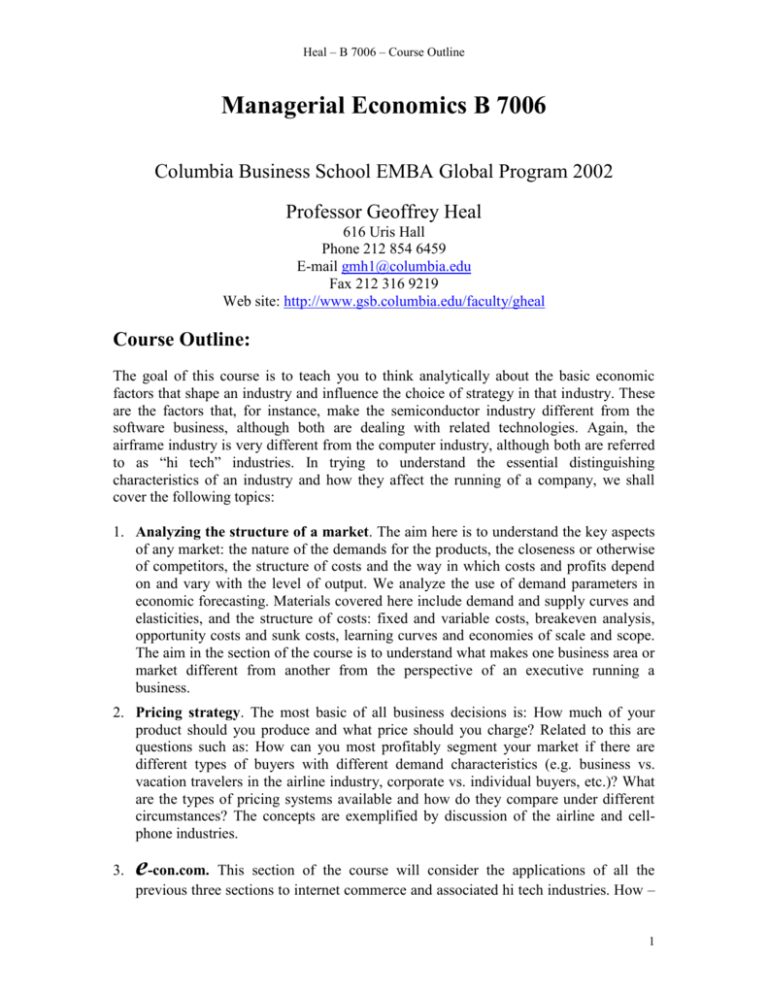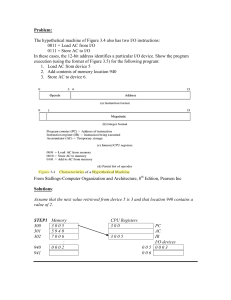Managerial Economics B 7007
advertisement

Heal – B 7006 – Course Outline Managerial Economics B 7006 Columbia Business School EMBA Global Program 2002 Professor Geoffrey Heal 616 Uris Hall Phone 212 854 6459 E-mail gmh1@columbia.edu Fax 212 316 9219 Web site: http://www.gsb.columbia.edu/faculty/gheal Course Outline: The goal of this course is to teach you to think analytically about the basic economic factors that shape an industry and influence the choice of strategy in that industry. These are the factors that, for instance, make the semiconductor industry different from the software business, although both are dealing with related technologies. Again, the airframe industry is very different from the computer industry, although both are referred to as “hi tech” industries. In trying to understand the essential distinguishing characteristics of an industry and how they affect the running of a company, we shall cover the following topics: 1. Analyzing the structure of a market. The aim here is to understand the key aspects of any market: the nature of the demands for the products, the closeness or otherwise of competitors, the structure of costs and the way in which costs and profits depend on and vary with the level of output. We analyze the use of demand parameters in economic forecasting. Materials covered here include demand and supply curves and elasticities, and the structure of costs: fixed and variable costs, breakeven analysis, opportunity costs and sunk costs, learning curves and economies of scale and scope. The aim in the section of the course is to understand what makes one business area or market different from another from the perspective of an executive running a business. 2. Pricing strategy. The most basic of all business decisions is: How much of your product should you produce and what price should you charge? Related to this are questions such as: How can you most profitably segment your market if there are different types of buyers with different demand characteristics (e.g. business vs. vacation travelers in the airline industry, corporate vs. individual buyers, etc.)? What are the types of pricing systems available and how do they compare under different circumstances? The concepts are exemplified by discussion of the airline and cellphone industries. 3. e-con.com. This section of the course will consider the applications of all the previous three sections to internet commerce and associated hi tech industries. How – 1 Heal – B 7006 – Course Outline if at all – does the internet change the way we should run a business? Is doing business electronically different from what has gone before? Text Book. The fifth edition of the text is significantly better than the previous ones, and includes more material and better presentations. It has a linked web site that you might find useful – http://cw.prenhall.com/pindyck To use the site, go to this URL, choose a chapter, and “begin”. On the left panel you see links to “current events”, “exercises” and others. Current events can be interesting: these links take to you applications of the material in the chapter to topical economic issues. I have printed some of these out in the notes that have been distributed to you. Course organization. The handouts that you have been given include copies of all the slides that I will use in class. This reduces the need to take notes. They also include printouts of various articles from the Financial Times, Business Week and other web sites that relate to the material in the course. I don’t always agree with what is in these articles, but you may find them thought provoking. I will also be distributing to you a spreadsheet that I would like you to work with during the first half of the course. Internet resources. There are several web sites that have interesting economic information and analysis. Obvious ones are www.ft.com (Financial Times), www.economist.com (The Economist), www.businessweek.com (Business Week). Less obvious are www.dismal.com, the web site of “the dismal science,” a good source of economic data and analysis, http://web.mit.edu/krugman/ the web site of Paul Krugman, an economist at Princeton who writes regularly for the NY Times and other magazines. (I particularly like his article on “The Seven Habits of Highly Defective Investors.” You’ll probably like it too, unless you’re a fund manager.) For economic data, US government web sites are good: www.irs.gov, www.bls.gov, (bls is Bureau of Labor Statistics – I assume you recognize irs.) Also www.whitehouse.gov will get you to the Economic Report of the President, which is a good collection of data and analysis on the recent performance of the US economy and the issues facing government policy makers. Cases. Preparing a case means reading the material, thinking about it, and writing a one page (200-300 words, more or less) summary of your responses to the questions it poses. This is to be handed in at the start of the class in which the case is discussed. Preliminary Reading: Text book (Pindyck and Rubinfeld (P&R), fifth edition.) Chapter 1, chapter 2, sections 2.1 to 2.3. Assessment There are three components to the assessment of this course: 1. Problem sets and cases. 20% of the final grade. 2. A final exam. 40% of the final grade. 3. A project. 40% of the final grade. This may be completed individually or cooperatively, in groups no bigger than the regular study groups. The project applies one or more of the concepts from the course to a business problem with which you are familiar or in which you are interested. The application of the concepts may be 2 Heal – B 7006 – Course Outline qualitative rather than quantitative – during the semester I will circulate an example of what I consider to be a good project report. The project report should be no more than five pages single spaced 12 points, plus data and diagrams. ………………………….. Course Schedule July 9, 10, 11, 13 (London): Topic for 9, 10, 11 July: analyzing the structure of a market: demand & supply. Reading: Text, chapter1, chap. 2, sections 2.1 to 2.5. Read all the examples in chapter 2. Prepare the Amax case for July 11. Topic for 13 July: Costs (beginning) Read text, chapter 7 sections 7.1 and 7.2. Then read section 7.4, and don’t pay attention to figure 7.7 which contains concepts I don’t cover. Read 7.6, and read all the examples for this chapter. Problem set 1: P&R, page 57, exercises 1, 2, 4. Due by August 8. August 8, 9, 10 (London). Topic for August 8, 9: Costs (continued). Read text, chapter 7 sections 7.1 and 7.2. Then read section 7.4, and don’t pay attention to figure 7.7 which contains concepts I don’t cover. Read 7.6, and read all the examples for this chapter. For August 9 prepare the TV Listing guide case. Topic for August 10: Pricing policy (beginning) Read text, sections 8.1 to 8.5. Then read 10.1 (skip the starred section on pages 227-8) and sections 10.2 and 10.3. Read 10.7 on anti trust laws. Finally read chapter 11, sections 1 through 5 Problem set 2: chapter 7 pages 243-244, exercises 3, 4, 7, 11. Due September 5. September 5, 6, 7 (New York). Topic for September 5, 6: Pricing policy (continued). Read text, sections 8.1 to 8.5. Then read 10.1 (skip the starred section on pages 227-8) and sections 10.2 and 10.3. Read 10.7 on anti trust laws. Finally read chapter 11, sections 1 through 5. For September 5 prepare the NYNEX pricing case. 3 Heal – B 7006 – Course Outline Topic for September 7: Economics of Electronic Commerce (e-con.com). There is not much on this in the text: read chapter 4 section 4.5 on adoption externalities (standards) and chapter 13 section 13.9 on auctions. There is plenty more reading in the handouts. Problem set 3: chapter 11 pages 409 on exercises 4, 8 (parts a and b only), 10, 12, 16. Due for September 15. 4
![【我們是你的百姓】 [ We are Your people ] 新歌頌揚377 我們屬於祢都](http://s2.studylib.net/store/data/005298903_1-fa3ea08f8bad91a00d5f15d00abd2df9-300x300.png)






